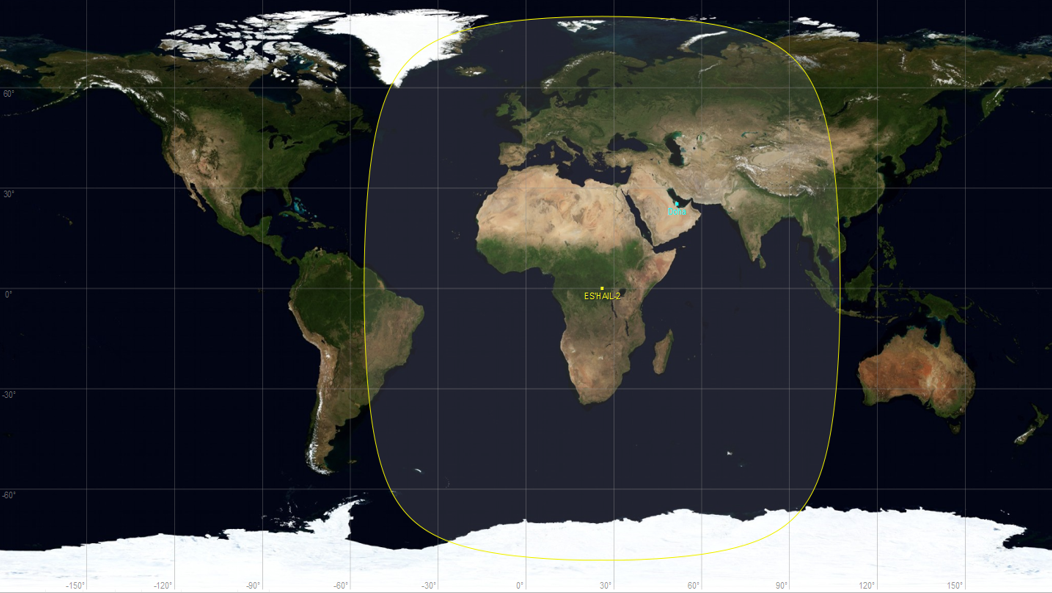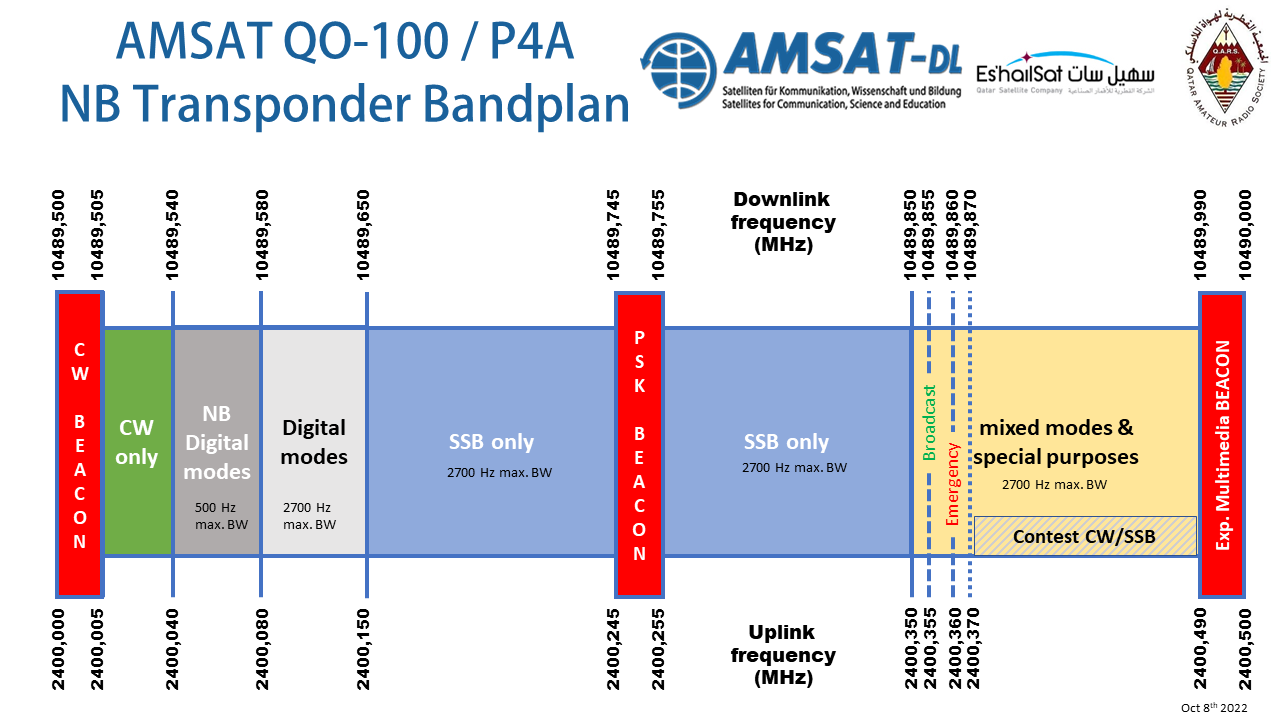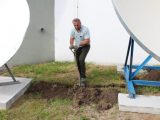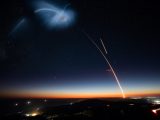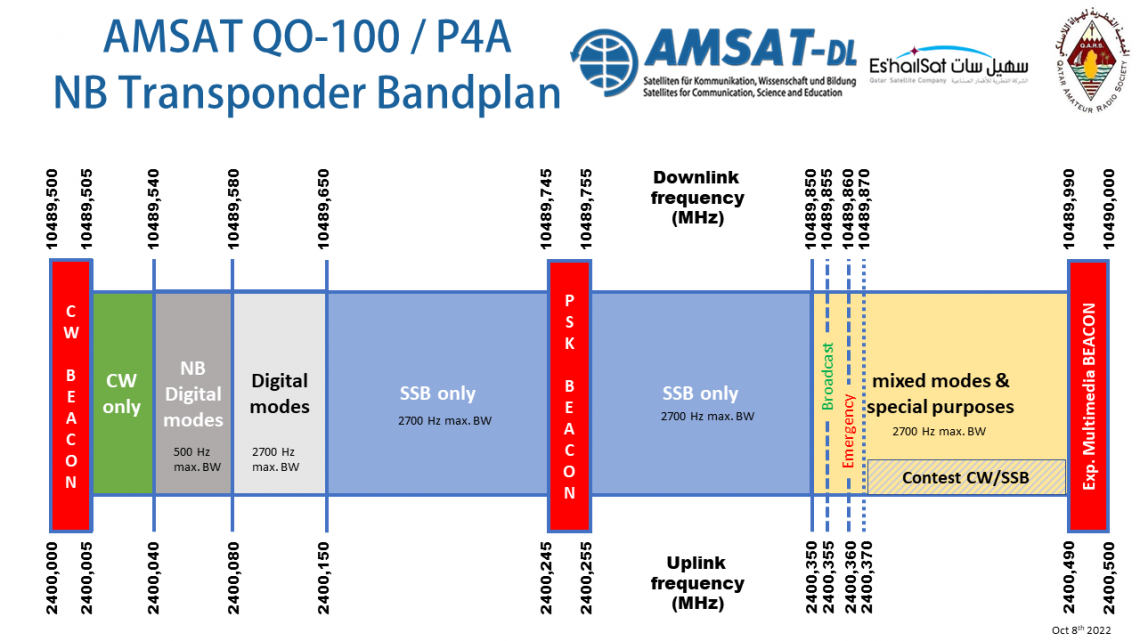
QO-100 NB Transponder Bandplan and Operating Guidelines
October 19, 2018Preface
Of all leisure activities, only licensed radio amateurs have the valuable privilege of experimental use of frequencies.
In addition to its rights to use frequency bands, the amateur radio service also has the privilege and obligation (for “self regulation”) to independently design the intended use of the allocated areas with radio applications (operating modes and band plans). This also includes the coordination of radio operation facilities such as beacons, relays and satellites.
AMSAT is indeed not in a position to play “Police”, we can only give recommendations and advice.
However, every radio amateur should be encouraged to help and advice others lacking technical experience. This should indeed be done in a friendly manner, not as a sheriff.
This document is being used as a guideline for the first AMSAT P4-A transponder on Qatar-OSCAR 100 (QO-100, Es’hail-2), the first geostationary amateur radio transponder. It will enable potential users to be informed about the plans and operating procedures that should be adopted. This document might be updated regularly to take into account the operational experience.
Frequency Chart
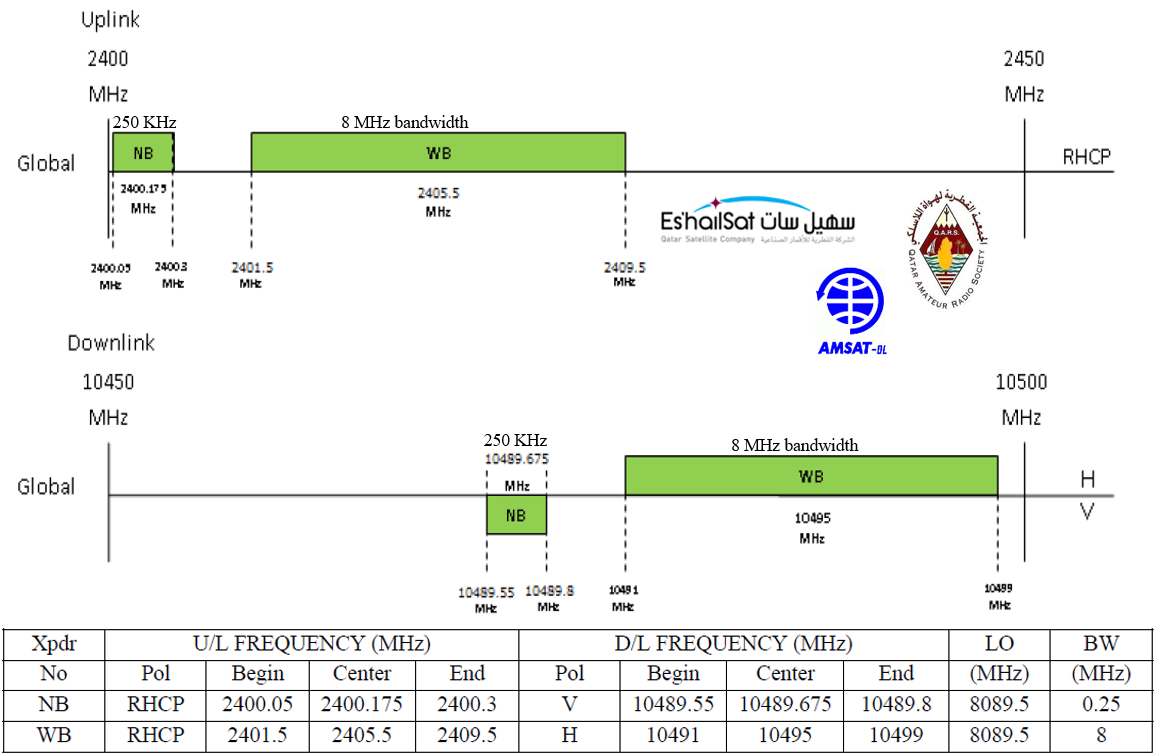
This chart shows the two transponders, their passbands and uplink and downlink polarisations. Note that, unlike the linear transponders on most other amateur satellites, these transponders are not inverting.
The two amateur band transponders on Es’hail-2 are a hosted payload being provided by the Qatar Satellite Company – Es’hailSat and the Qatar Amateur Radio Society (QARS) in co-operation with AMSAT-DL. It is vital that operators respect this facility and refrain from any activity that might cause offense, or which is outside the terms of their amateur radio licence.
QO-100 NB-Transponder Operating Guidelines and Bandplan
The narrowband transponder is intended for conventional analogue and narrowband digital signals with maximun 2.7 kHz bandwidth.
No transmissions should be made beyond the nominal edges of the transponder passbands. In particular, no operation should take place below the lower beacon nor above the upper beacon (now also called experimental beacon).
No uplinks should result in downlink signals that are stronger than these beacons. In the event that such signals are detected, they will be marked by a “LEILA” siren. When they have been marked by “LEILA”, operators should immediately reduce their uplink power (ERP).
No FM transmissions should be made to Es’hail-2 as these would use excessive power and bandwidth.
On February 14th the NB Transponder Bandplan was extended according to the following graphics.
Bandplan:
| Uplink Start [MHz] | Uplink End [MHz] | Downlink Start [MHz] | Downlink End [MHz] | total BW [kHz] | Description |
| – | – | 10489,500 | 10489,505 | 5 | Lower Beacon 10489,500 MHz, CW F1A 400Hz shift, + guard band |
| 2400,005 | 2400,040 | 10489,505 | 10489,540 | 35 | CW only |
| 2400,040 | 2400,080 | 10489,540 | 10489,580 | 40 | digimodes (500 Hz max. BW) |
| 2400,080 | 2400,150 | 10489,580 | 10489,650 | 70 | digimodes (2700 Hz max. BW) |
| 2400,150 | 2400,245 | 10489,650 | 10489,745 | 95 | SSB only (2700 Hz max. BW) |
| – | – | 10489,745 | 10489,755 | 10 | Middle Beacon 10489,750 MHz, 400 Bit/sec BPSK, + guard bands |
| 2400,255 | 2400,350 | 10489,755 | 10489,850 | 95 | SSB only (2700 Hz max. BW) |
| 2400,350 | 2400,3575 | 10489,850 | 10489,858 | 7,5 | Broadcast frequency 10489,855 MHz + guard bands |
| 2400,3575 | 2400,365 | 10489,858 | 10489,865 | 7,5 | Emergency frequency 10489,860 MHz + guard bands |
| 2400,365 | 2400,490 | 10489,865 | 10489,990 | 125 | mixed modes (2700 Hz max. BW) & special purpose (incl. contest) |
| – | – | 10489,990 | 10489,997 | 7 | Multimedia Beacon, 10489,9935 MHz, 8APSK, 7200 Bit/sec, + guard bands |
| – | – | 10489,997 | 10490,000 | 3 | Upper Beacon 10490,000 MHz, CW F1A 400Hz shift, + guard band |
- Amateur Radio is a self-regulating radio service, so please respect some rules when you are operating within the amateur satellite service, i.e. over a satellite transponder:
- Not stronger than the Beacon, keep your signal below Beacon level.
- No FM mode or any other modulation exceeding max. 2700 Hz bandwidth is allowed on the NB transponder.
- No digital FM modes like C4FM, DSTAR and others, same rule as above!
- No transmission below the Lower Beacon (CW): the Amateur Satellites Service operate exclusively on a secondary basis in the band 2400-2450 MHz. You are responsibly for you own transmissions!
- No transmission above the Upper Beacon (experimental beacon, currently CW).
- Please keep the “guardband” around the CW & PSK beacons free of transmissions and don’t interfere with it.
- The NB transponder is a bent-pipe transponder and non-inverting.
- Uplink polarisation is RHCP (right-hand circular polarization).
- Downlink polarisation for the NB transponder is V (vertical linear polarization).
- Excessive signals might trigger LEILA warnings to remind you to reduce uplink power.
- Full-Duplex operation is mandatory (you must be able to monitor your own downlink while transmitting!)
- The Middle Beacon is modulated in 400 bit/s BPSK (similar to the P3-satellites).
- The beacons are generated by the groundstation with GPS locked reference and will carry additional operational or maintenance information.
- Gateway traffic and relaying is prohibited and only permitted during disaster communication, see below.
Remote Operation via QO-100
Remote operation of an amateur radio station via QO-100 is only permitted if the station belongs to the operator himself and is operated at his own location. He must always have full control over the station and in particular be able to switch it off immediately if, for example, interference occurs. Special cases of permitted unmanned and automatically operating stations applies only to disaster radio communication over QO-100 in humanitrarian emergency situations and require both permission from the operator of the space station, in this case represented by AMSAT-DL, and special permission from the regulatory authority responsible in the respective country. The international and national legal regulations must always be complied with by the operator. The above agreement is in accordance with AMSAT-DL, AMSAT-UK, QARS and Es’hailSat.
Remote operation used by groups (private or club stations, gateway traffic) is not wanted by the satellite operator.
Coverage Map
This map shows the coverage expected using the global beams on the spacecraft. For broadcast satellites it is usual to show the coverage down to 5 degrees elevation, but it is expected that well sited locations may provide access beyond that shown. The actual limits and power/dish sizes required will not be known until after commissioning.

Here is another map shopwing the maximum possible visibility area at 0° elevation angle:
